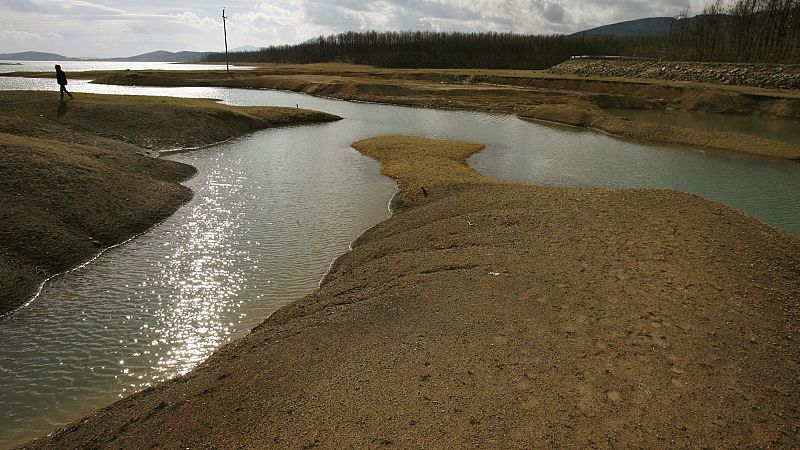Water Reservoirs in Attica Face Historic Decline
Water reservoirs in Attica, the Greek region that includes Athens, are reaching historic lows, according to a recent analysis conducted by the FloodHUB service of the BEYOND Operational Unit. This assessment focuses on the water supply system serving the region and highlights the growing pressure on its resources.
The research team found that the water supply system is under significant stress due to prolonged drought conditions over recent years. The system relies on four main reservoirs: Mornos, Evinos, Yliki, and Marathon. Among these, Mornos is the primary source, supplying the largest volume of water. The Evinos reservoir works in conjunction with Mornos through an underground tunnel, acting as a transitional reservoir. Yliki and Marathon serve as complementary sources, supporting the overall system.
To evaluate the current state of the reservoirs, the FloodHUB service analyzed hydrological and climatic conditions for the first half of 2025. The study used data from various satellite systems, including Landsat-5, 7, and 8 (1984–2021) and Sentinel-2 (2017–2025), to estimate the surface area of the lakes. Additionally, ERA5-Land climate data (1950–2025) was utilized to assess monthly and daily climate variables related to drought and heat stress.
Surface Area Trends of Key Reservoirs
Lake Mornos, one of the most critical reservoirs, showed a marked decline in surface area. In May 2025, the lake covered only about 65% of its maximum historical level for that month. This is significantly lower than previous years, such as 2024, when it reached 79%, and 2022, which saw nearly full capacity. The current surface area of around 11.64 km² is among the lowest recorded since the Evinos reservoir was integrated into the system in 2002, with the exception of 2008, when the area dropped below 10 km².
Similarly, Lake Evinos, which plays a crucial role in the system, experienced a sharp decline. By May 2025, its surface area had fallen to just 2.30 km², well below the overflow level of 3.6 km². The 2024 values were also low, while earlier years like 2021 and 2022 showed more favorable conditions.
Climatic Conditions and Drought Impact
Climatic conditions in 2024 further exacerbated the situation at both Lake Mornos and Lake Evinos. Low snow cover (less than 10%), high heat stress (around 30%), and reduced precipitation (SPI-3 < 0, indicating a hydrological drought) contributed to the worsening scenario. In 2025, conditions improved slightly, with the SPI-3 index ranging between -0.5 and +1, snow cover at around 20%, and heat stress below 10%. However, these improvements were not enough to offset the long-term decline in water levels.
At Lake Evinos, there was no evidence of significant precipitation or a substantial reduction in drought conditions. The reservoir’s small storage capacity made it particularly vulnerable to dry spells.
Current Reservoir Levels and Implications
As of May 2025, the reservoir levels have approached the second-lowest levels observed in the last 20 years. While 2008 remains the worst year in terms of hydrological stress, 2025 shows similar characteristics. Over the past few years, the surface area of the Mornos reservoir has shown a continuous downward trend. Although the 2025 precipitation index indicates some improvement compared to 2024, this has not been sufficient to replenish the stored water. Instead, there has been a roughly 10% decrease in water levels from the previous year.
Evinos appears to be even more affected by drought conditions due to its limited storage capacity. As of early 2025, both reservoirs are operating at around 60% of their capacity, intensifying the hydrological stress on the entire system.
Broader Context of Water Scarcity in Greece
Greece is facing an increasing water scarcity crisis, ranking 19th globally for water shortage risk, according to a World Resources Institute study and a Deloitte report commissioned by the Greek government. The country faces severe challenges driven by factors such as tourism, agriculture, and aging infrastructure.
About the BEYOND Operational Unit
The BEYOND Operational Unit, part of the Space Applications and Satellite Remote Sensing Unit, specializes in identifying hazards and protecting societies, the environment, and critical infrastructure from natural, man-made, or near-space threats. It provides continuous monitoring services for natural disasters across South-Eastern Europe, the Balkans, the Middle East, and North Africa. Through the Copernicus Emergency Management Services programme, BEYOND supports global crisis management agencies in addressing a wide range of natural disasters, including fires, extreme weather events, volcanic activity, landslides, soil erosion, water shortages, toxic industrial accidents, earthquakes, floods, and desert dust and smoke transport.







